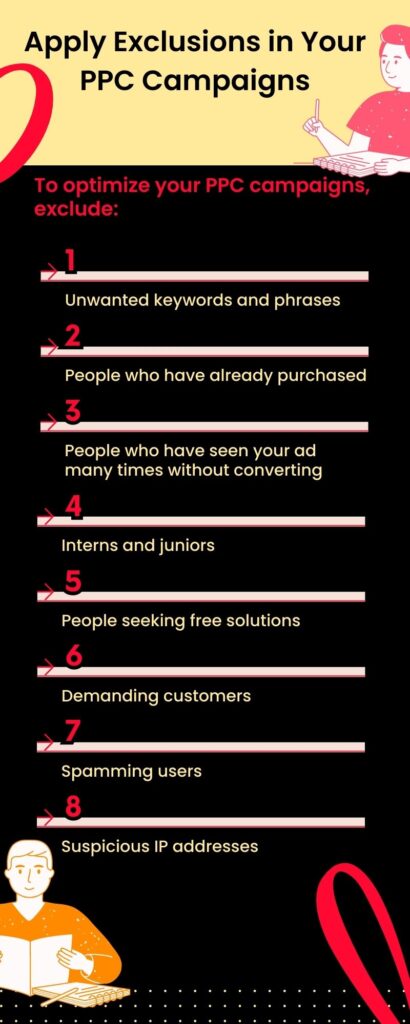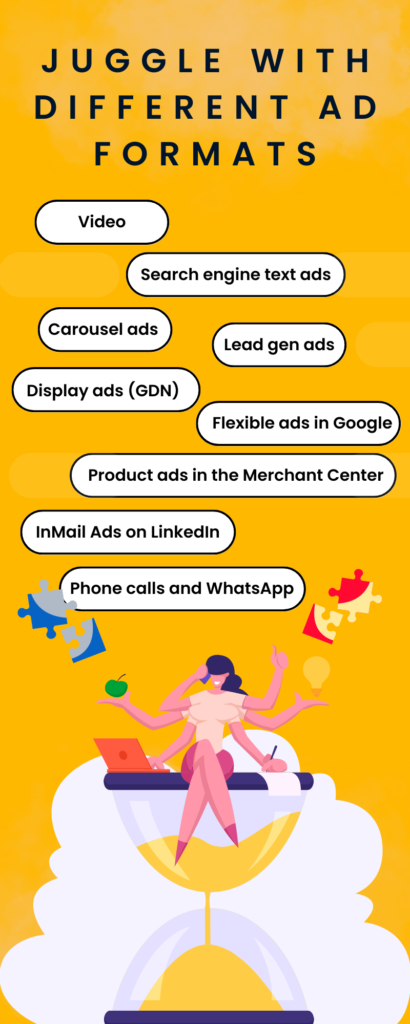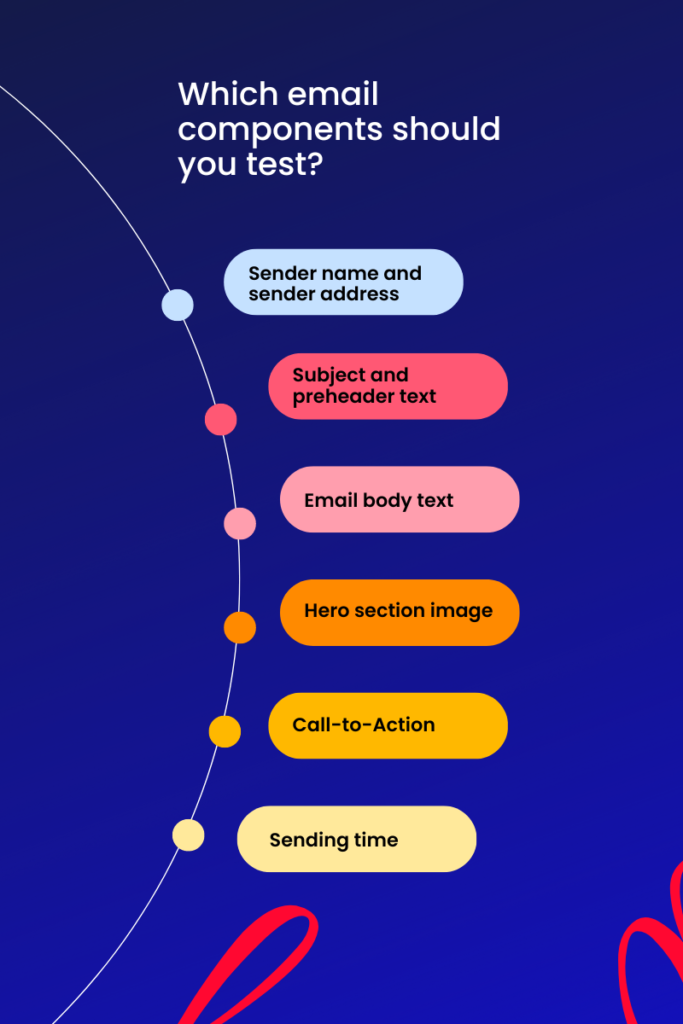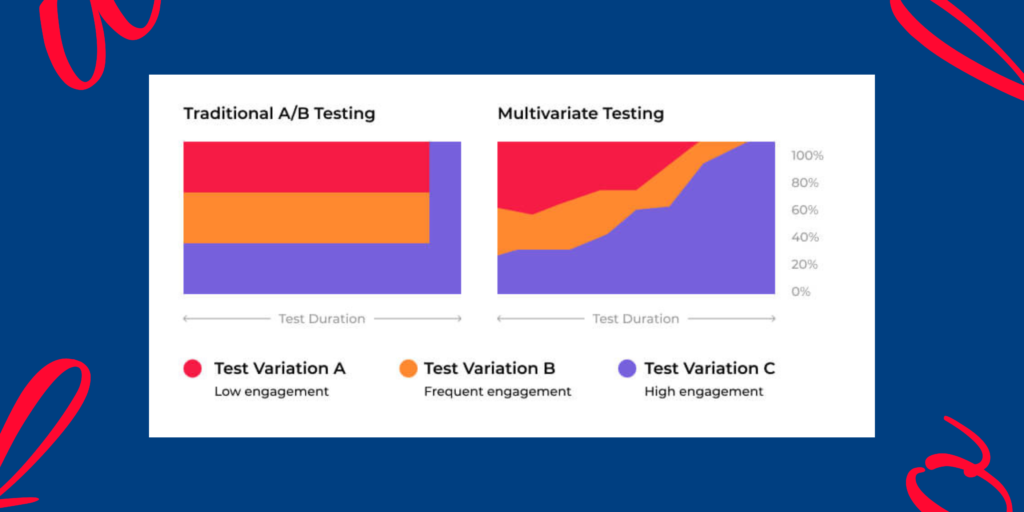PPC optimization may be a piece of cake, if you’re long enough in the game and you have experience with making swift decisions based on data.
But, it can be more challenging, if you’re at the beginning of your paid digital adventure. Or, if you have reached the moment of: “OK, I’ve done everything to refine my campaign setup, and it still doesn’t work”.
In this technical guide, I will share my hands-on insights and tips for improving your PPC campaign performance.
Make sure the content is relevant
Before you set up your campaign and switch on your ads, make sure the content on your landing page is spot on.
First, there must be a match between the ad’s messaging and what’s written on the landing page. It may seem obvious, but often there’s a disconnect at this fundamental level, which makes potential customers confused and eager to bounce from a website.
Second, double down on your content’s quality and credibility. Collaborate with your writer and designer (either internally or externally) to deliver:
- comprehensive and specific product or service descriptions
- high-end images and web design
- clear benefits for customers
- simple pricing
- company’s contact information and terms and conditions.
Plan your campaign budget
Ask yourself a question and be honest — how much money do you have for your PPC advertising campaign?
You must be realistic and plan your budget according to your financial capabilities. Running sponsored display campaigns all over the Internet won’t take you anywhere close to your business’s incremental gains.
Instead of burning your campaign budget and achieving poor results, rationalize your spending.
Choose your digital marketing channels
There are a lot of online marketing programs out there to drum up your website traffic and sales figures:
- Getting high-intent organic traffic from search engines. And I don’t only mean the good-old Google. There are other players you need to have on your radar: DuckDuckGo, Bing, Yandex, YouTube, or Amazon.
- Organic social posts — although the key social platforms (especially Meta) keep changing their algorithms to trim the reach of organic posts, brands, and solopreneurs still achieve remarkable results on LinkedIn or TikTok.
- Email marketing — is an absolute must-have for all brands. Whether you’re operating SaaS or e-commerce, email marketing is a powerful channel to drive leads and sales and onboard and retain customers.
- Affiliate marketing — having an attractive and robust affiliate program on your website can generate a stable stream of new customers.
- Review platforms — if you’re in the SaaS game, building your presence in G2, Capterra, TrustPilot, TrustRadius, is substantial. Your competitors are there. And so should you.
- Paid search — the second one is about bidding on commercial keyword terms important for your business and getting listed with a compelling text ad at the top of search engine results.
- Paid social — one of the pillars of successful PPC campaigns is running sponsored content on Facebook, Twitter, LinkedIn, Instagram, YouTube, Quora, Xing, and TikTok.
As you progress, it’s worth being active in most channels and optimizing ways to reach your potential customers.
One of the most efficient channels is email marketing. So, implementing marketing automation workflows should be on your priority list. All other marketing channels should be orchestrated in a way for email marketing to be the final stage of the customer journey.
Plus you need to effectively juggle with different content formats:
- Articles
- Text ads
- Graphics
- Videos
- Events
- Newsletters
- Product descriptions
- Email blasts
- Infographics, etc.
Your PPC campaign optimization will come naturally due to deploying all activities and content assets. You only need to monitor the metrics and allocate more budget where you can see a lower Cost per Acquisition (CPA).
Set up your campaign goal
Match the campaign goals settings in ad managers to your own goal you want to achieve:
Conversions
What I mean is all activities users take on your website as an effect of interacting with your advertising campaigns. And those boil down to:
- purchasing a product
- adding a product to the cart
- booking a product demo call
- filling in a contact form
- ebook download
- newsletter sign-up
- interacting with specific content on your website, etc.
Web traffic
Another goal of your campaign can be simply increasing traffic to your website. Let’s say you just rolled out a new home page or a set of product or feature pages.
And instead of waiting for each of them to start ranking for relevant keywords, you want to get crowds of visitors through an optimized PPC campaign strategy.
Community building
However, if the idea behind your PPC optimization campaign is about building engagement and growing the community of your followers on social media, you can calibrate your campaign towards that goal.
From my experience, it works perfectly if you promote organic social posts through sponsored display ads. This way, you optimize for building a tribe around your brand.
Watching a video
Suppose you want to drive your target audience to watch a video ad, and this activity is more important than visiting your website or conversion rate. In that case, you should define it as a goal and measure that metric precisely.
In that approach, you achieve a more comprehensive range of audience (videos are “algorithm friendly”) and should focus on time engagement with engaging communications from recordings rather than conversions or clicks.
Be clear about your goal
Setting up a goal is crucial to optimize PPC. Why? Let’s say, you’re about to deploy a Black Friday promo campaign. If you define advertising reach/coverage as a campaign goal, you will not be able to meet the sales goal quantitatively.
Look after your time parameters
Define a strict time frame for promotion. More simply put — from when to when the ads should run. This way, you’ll avoid displaying ads when you don’t want them. It is a healthy prevention to avoid burning your budget.
Optimize your ad display schedule
- Accelerated vs. Standard: An accelerated schedule quickly consumes the daily budget — even within an hour or two. It can be a good option for SaaS businesses, as customers have a higher purchasing potential throughout the day. However, a standard schedule, where the budget is spent over 24 hours, is a proven method and worth implementing.
- Days of the week: You should think about running your ads seven days a week, Monday to Friday, or on selected days. In many industries, Fridays tend to be less effective. If your results drop on Fridays, decrease promotion intensity and bring it back to full speed on Mondays.
- Hours of the day: User activity increases from 5 to 7 in the morning, then often at 9 AM. Lunchtime is usually a period of decreased activity, so that you might allocate fewer funds during this time. You can expect increased activity among small business owners during afternoon and evening hours (4 PM – 8 PM). So, investing more money during these periods can be a great idea.
- Combination of hours on specific days: Individual optimal time ranges will emerge during the promotion. Identify the best time ranges for each day and adjust them in the settings to allocate the budget accordingly.
Your target audience’s characteristic vs PPC optimization
Now, it’s time to discuss optimizing the ad schedule for PPC campaigns to maximize their effectiveness. We will focus on several key aspects to consider when planning a campaign:
- Location: Defining the geographical area where ads should be displayed is crucial to target ads to the right audience. Instead of choosing an entire country, consider focusing on the largest cities or, conversely, on less populated areas that may require courier delivery or online shopping.
- Language of the audience: A good practice is to match the language of the ad to the language of the audience. If the ad is in French, it’s advisable to target French speakers, especially in multilingual countries.
- Demographics of the audience: It is essential to consider demographic factors such as gender, age, or social status. For example, when promoting language courses for children, it’s worth directing ads to mothers, who often decide to enroll in such classes. Similarly, advertising gardening tools targets men who make these purchases more frequently.
- Targeting by a hierarchy of importance: Ads can be directed based on various criteria such as keywords (popular and long-tail), job positions, employers, thematic groups, skills, or interests. Choosing the criteria that best match the ad to the target audience is essential.
Consider these four aspects when planning and optimizing the ad schedule for PPC campaigns. It will help target ads to the right audience, increasing their effectiveness and achieving better results.
Apply Exclusions in PPC
Using exclusions is an essential part of stellar PPC optimization. Start by excluding unwanted keywords (e.g., free, subsidized, opensource), followed by undesirable phrases users have entered in search engines (check the „searched terms” report).
Additionally, consider implementing the following exclusions for PPC optimization in prospecting:
- Exclude remarketing: Remove those who have already purchased, have seen the ad multiple times without converting, interns and juniors, or those seeking free solutions.
- Exclude problematic contacts: Create a list of spamming users or demanding customers, suspicious IP addresses, people who haven’t watched a video to the end, and so on.
- Exclude inappropriate content: For serious businesses, avoid directing ads to content that is drastic, erotic, shocking, or otherwise not suitable for the message you’re conveying.

Invest in external tools to prevent suspicious ad clicks, such as click fraud software like ClickCease, TrafficGuard, or ClickGuard. These tools usually block IPs with excessive clicks, helping you avoid wasting significant ad money and improving ad quality.
Simultaneously test the potential of different audience groups by running paid content. Let’s play with potential business software clients’ examples. Here, you can use:
- Remarketing to those who wanted to buy but didn’t (add to cart),
- Remarketing to visitors of pricing and/or important blog articles subpages,
- Remarketing to lower-value customers (who tested software long ago) to convert them into higher-value customers,
- Prospecting „lookalike” audiences based on who had bought your software (good practice is to launch both lists based on email lists and url conversions),
- Prospecting people interested in “enterprise software”, “software as a service”, “small business software”, “business intelligence tools” and similar keywords.
Consider and list the audience groups you have.
For display network campaigns, exclude inappropriate websites or apps or provide no advertising value beyond impressions (such as children’s games, gambling apps, or trendy gadgets among young people).
Look after the physical ad placement on social media
There’s no need to bother about placing your ads everywhere, especially for beginners. In practice, however, one placement is crucial: the newsfeed (feed). For PPC optimization, you can disable the rest of the placements or keep only the stories.
Devices — mobile or desktop?
In recent years, the „mobile-first” approach has dominated website traffic, and it’s true for most businesses. However, some companies see more sales or cheaper conversions from desktop devices.
For PPC optimization purposes, you can either disable targeting on mobile devices or significantly reduce (-X%) spending on them.
Juggle with different ad formats
Ad formats play an essential role in PPC campaigns. Let’s break them down:
For the last couple of years, marketers have been repeating a mantra of „this year will belong to video”. Social media algorithms indeed adore video content and can help you boost your reach. But ensuring it aligns with your advertising objectives is essential since it might not always be super effective.
When it comes to search engine text ads, they’re reliable and effective but can be costly. They might not work as well in display networks or social media, where they can generate many impressions but few conversions.
Product ads in the Merchant Center can be a game-changer for e-commerce businesses, often being more affordable than text ads.
Carousel ads on social media? Definitely worth a shot – they’re pretty effective! As for single-image ads, they’re a classic and versatile option you should try to use whenever possible. I recommend simultaneously emitting more carousel ads with 2-3 images than one with 5-6 images because the further image is much less viewed and clicked.
Lead ads can be great for generating leads, but be mindful of their cost-effectiveness, as they can get pricey. The longer it goes on, the more spam it will catch. It is better to use short periods.
Display ads in the Google Display Network (GDN) might get you plenty of impressions and clicks, but they’re not always the most effective option. I suggest using display ads as an additional format or an extension to other advertising formats you have introduced in your campaigns.
Flexible ads in Google combine the power of text and visuals, making them a time-saving and effective advertising choice.
InMail Ads on LinkedIn are interesting because they allow for solid personalization. Just remember that crafting an engaging message is critical.
If your business relies on voice communication with potential customers, pay attention to ads with phone calls and WhatsApp.

Experiment with other formats
Lastly, feel free to experiment with other ad formats like smart, DSA, discovery, and spotlight ads. They might not always be the perfect fit, but it’s worth giving them a try.
Remember, it’s essential to evaluate each ad format’s suitability for your specific goals and tweak your PPC campaign for the best results.
Experiment with persuasion in messaging
When it comes to ad messaging, don’t be afraid to get persuasive and creative! A lot of times, ads are just too generic and don’t encourage people to take action.
So, how can you make your ads stand out and really connect with potential customers? Here are a few ideas to consider:
- Limited availability: Make your offer feel exclusive by mentioning that there are only a few items left, like the last 20 items, the last two hotel rooms available, or just 50 pairs of shoes available nationwide.
- Time constraints: Add a sense of urgency by specifying that the offer is only valid for a limited time, such as until the end of the week or with a reservation deadline at 11:59 PM on a specific date.
- Offer type: Is your promotion a first-minute or last-minute deal? Or perhaps you want to play with the exclusiveness of a specific channel – for instance, your potential clients come across your video ad on Facebook, offering a 10% discount on your product. Emphasize that this deal is only available here, and not on LinkedIn or Instagram.
- Additional benefits: Sweeten the deal with extra perks, like a free add-on purchase, longer usage time, free of charge consultation hours, a recording of a meeting, or a certificate or membership card.
- Discount: e.g. -20% for the annual package or -10% on our “4th birthday”. I do not recommend promoting offers at a discount for a fee because the profitability of the venture drops sharply.
By using these persuasive techniques in your ad messaging, you’ll have a better chance of inspiring potential customers to take action, making your advertising campaign that much more effective.
Extra tips for optimizing your PPC campaigns
When it comes to optimizing your PPC campaigns, it’s essential to keep an eye on your results and profitability.
Don’t just rely on ad managers; use tools like Google Analytics and your own database systems to get the full picture.
Keep tabs on important metrics like CPA (Cost Per Acquisition), ROI (Return on Investment), and ROAS (Return on Ad Spend) to see what’s working and what’s not.
Here are some helpful tips to keep in mind when optimizing your PPC campaigns:
- Timing is everything: Make optimization changes as soon as a day after launching a campaign. Start by evaluating performance daily. Then, switch to a weekly basis, comparing weekends to weekdays. Be sure to consider seasonal changes, too!
- Set limits, but do it wisely: Gradually lower your CPA limits to avoid hindering the advertising algorithm’s learning capabilities. This way, you can focus on increasing profits without causing any hiccups.
- Time is money: Remember, the time spent managing ad campaigns is also a cost, so be mindful of how you allocate your time.
- Don’t copy and paste: Avoid duplicating the same strategies across different channels, as they may behave differently and require tailored content.
- Test, test, test: Conduct A/B tests to identify which variables affect results (text, graphics, pricing, landing page, audiences, variant of the offer, e.g. single product or set?) and keep the best-performing ad variants while pausing weaker ones. Always be on the lookout for ways to create even better ads!
Time to drum up your advertising results!
In a nutshell, PPC optimization is an ongoing process that needs your attention. There’s no such thing as a perfect, self-improving system. So, if you’re serious about performance marketing, always be ready to analyze and adjust the parameters you can control. Stick to these tips to help rationalize advertising expenditures and prevent unnecessary financial losses.
If you need help — Cayenne Flow agency can manage and optimize your next PPC campaigns. Drop us a line or book a call today!




